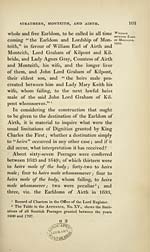History of the earldoms of Strathern, Monteith, and Airth
(128) Page 100
Download files
Complete book:
Individual page:
Thumbnail gallery: Grid view | List view

100 HISTORY OF THE EARLDOMS OF
William But, siipposing that the pevsoual Honours as
orMoNTEiTH!^ well as the lands of Monteith and Airth were
1633. united, there is nothing in the Patent to prohibit
them from being severed, or to render the en-
joyment of the one, absolutely dependent upon
the possession of the other. On the contrary,
the clause by which the Charter of the Eaj'ldom
of Monteith is protected and declared to remain
in full vigour and integrity, seems rather to shew
that a separation of the two Earldoms was con-
templated ; for such clauses were introduced into
otherPatentsof Honours with that express object.'
The separation thus foreseen and provided
for was (as will afterwards be stated) autho-
rised by a Royal Charter with respect to the
^ territorial Earldoms of Monteith and Airth in
less than fifty years after their annexation-; and
eleven years only had elapsed before the lands
of Monteith were again erected into an Earl-
dom, without any notice whatever being taken of
the lands or Earldom of Airth.
On the 11th of January, 1644, King Charles
the First, proceeding on the resignation of the
Earl of Airth and Monteith of various lands of
the Earldom of Monteith, was pleased to newly
erect and incorporate the said lands into one
1 See the Patents of the Dukedom of Lauderdale in 1672 ;
of the Dukedoms of Gordon and Queensberry in 1684 ; of the
Marquisate of Atholl in 1676, and the Earldoms of Rothes
in 1680, and Kinnoull in 1704.
2 Vide pp. 108, 109. postea.
William But, siipposing that the pevsoual Honours as
orMoNTEiTH!^ well as the lands of Monteith and Airth were
1633. united, there is nothing in the Patent to prohibit
them from being severed, or to render the en-
joyment of the one, absolutely dependent upon
the possession of the other. On the contrary,
the clause by which the Charter of the Eaj'ldom
of Monteith is protected and declared to remain
in full vigour and integrity, seems rather to shew
that a separation of the two Earldoms was con-
templated ; for such clauses were introduced into
otherPatentsof Honours with that express object.'
The separation thus foreseen and provided
for was (as will afterwards be stated) autho-
rised by a Royal Charter with respect to the
^ territorial Earldoms of Monteith and Airth in
less than fifty years after their annexation-; and
eleven years only had elapsed before the lands
of Monteith were again erected into an Earl-
dom, without any notice whatever being taken of
the lands or Earldom of Airth.
On the 11th of January, 1644, King Charles
the First, proceeding on the resignation of the
Earl of Airth and Monteith of various lands of
the Earldom of Monteith, was pleased to newly
erect and incorporate the said lands into one
1 See the Patents of the Dukedom of Lauderdale in 1672 ;
of the Dukedoms of Gordon and Queensberry in 1684 ; of the
Marquisate of Atholl in 1676, and the Earldoms of Rothes
in 1680, and Kinnoull in 1704.
2 Vide pp. 108, 109. postea.
Set display mode to:
![]() Universal Viewer |
Universal Viewer | ![]() Mirador |
Large image | Transcription
Mirador |
Large image | Transcription
Images and transcriptions on this page, including medium image downloads, may be used under the Creative Commons Attribution 4.0 International Licence unless otherwise stated. ![]()
| Histories of Scottish families > History of the earldoms of Strathern, Monteith, and Airth > (128) Page 100 |
|---|
| Permanent URL | https://digital.nls.uk/94881378 |
|---|
| Description | A selection of almost 400 printed items relating to the history of Scottish families, mostly dating from the 19th and early 20th centuries. Includes memoirs, genealogies and clan histories, with a few produced by emigrant families. The earliest family history goes back to AD 916. |
|---|

